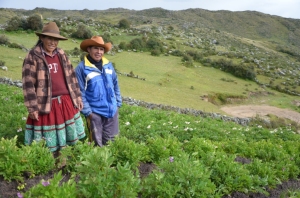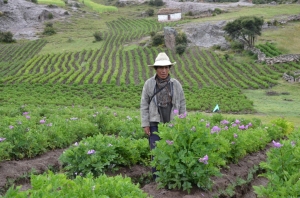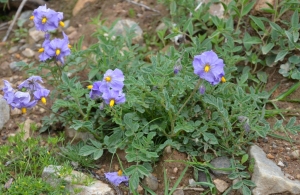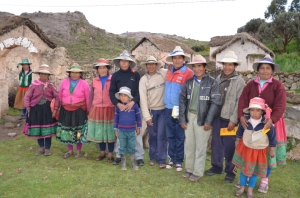 Last week I was privileged to spend a small week in the field together with colleagues from CADEP to visit custodian farmers living in the communities of Huancancalla, Pauchi, Yuricancha and Queuñapampa (district of Haquira, Cotabambas, Apurimac, Peru). The district of Haquira has 36 farmer communities and numerous potato landraces are commonly grown in sectoral fallowing systems, locally called mullu’s. The field visit was an opportunity to personally get to know one of the diversity hotspots of the Chirapaq Ñan Initiative in an area where traditional Quechua communities are now confronted with large scale mining development. This 2013-2014 cropping season a total of 17 households are participating with on-farm trials for the characterization and documentation of their potato landrace collections. Enrique Cruz Saramiento and Yolanda Negron Abiaja from Huancancalla are custodian farmers conserving well over 50 landraces. Cheqchicu is a favorite landrace of Yolanda because it is floury, delicious and cooks fast. Enrique remembers that when he was a kid the area cropped with Poqaya was much larger than it is nowadays. However, this landrace is now slowly making a return as it resists hail and frost. Juvenal Mayllko from the community of Qqueuñapampa grows 39 varieties. He says “it is my wife who is really most knowledgeable about the Quechua name of each variety: she knows how to name each of them”.
Last week I was privileged to spend a small week in the field together with colleagues from CADEP to visit custodian farmers living in the communities of Huancancalla, Pauchi, Yuricancha and Queuñapampa (district of Haquira, Cotabambas, Apurimac, Peru). The district of Haquira has 36 farmer communities and numerous potato landraces are commonly grown in sectoral fallowing systems, locally called mullu’s. The field visit was an opportunity to personally get to know one of the diversity hotspots of the Chirapaq Ñan Initiative in an area where traditional Quechua communities are now confronted with large scale mining development. This 2013-2014 cropping season a total of 17 households are participating with on-farm trials for the characterization and documentation of their potato landrace collections. Enrique Cruz Saramiento and Yolanda Negron Abiaja from Huancancalla are custodian farmers conserving well over 50 landraces. Cheqchicu is a favorite landrace of Yolanda because it is floury, delicious and cooks fast. Enrique remembers that when he was a kid the area cropped with Poqaya was much larger than it is nowadays. However, this landrace is now slowly making a return as it resists hail and frost. Juvenal Mayllko from the community of Qqueuñapampa grows 39 varieties. He says “it is my wife who is really most knowledgeable about the Quechua name of each variety: she knows how to name each of them”. 

We visited the potato farmer Hugo Alvarez, but he was very busy purifying gold from his informal mine. The shaft of the primitive venture was located just above his small family house made of adobe bricks and covered with a Stipa ichu grass roof. Hugo commented: “we purify the minerals with mercury, but one has to be careful to use gloves when having a small wound”. Just in the field below where the mercury was employed Hugo’s cows were grazing. It was evident that more than 500 years of gold mining had not brought development. On the way to his potato field at 4,200 m of altitude Hugo commented on a payment to Mother Earth (Pachamama) that he was about to conduct in April. According to ancient Andean mining traditions a living being, often a human being but in this case an alpaca, was to be sacrificed so that the mine would continue to produce abundant minerals. Hugo said “a local healer (curandera) will read the heart of the alpaca and make predictions about future production”. We just learned that an ancient tradition is still very much alive in this remote highland region. Some of the widely grown landraces in Haquira are Ccompis and Sua Llulla. Ccompis is a so-called cosmopolitan landrace that is grown all the way from Puno to Junín, thus covering at least a range of 2,000 km along the Andean range. Sua Llulla, literally meaning “lying thief”, is a regionally important landrace restricted to southern Apurimac and northern Cusco. The Chirapaq Ñan Initiative is currently developing a detailed baseline study of the diversity present in Haquira and an initial estimate based on nominal, morphological and genetic information suggests that this hotspot at least contains 150 unique potato landraces. Landraces named Salamanca, Ñawi Pasña (= “girls eye”), Michi Senqa (= “cat’s nose”), Linli, Sapo Ningri, Asñu Qurutu (= “donkey testicles”), Yuraq Waña and Putis are typical in the region. Duraznillo is a potato landrace that is regionally used for marriages and combines well with pig meat.
 On our last day in the field Juvenal Mayllko tells about the special Araqa potatoes that grow as tolerated weeds in the maize fields at the lower altitudinal limits of the community. Tubers from these semi-wild potatoes are collected in February and March to provide early produce to nurture the family during the lean season (7 months after the main harvest). Juvenal continues “last year my wife also planted Araqa tubers in a field with faba beans; they did really well and can now be harvested and don’t need to be cultivated anymore”. I was fascinated once again by the ability of these young Andean farmers to continue to drive crop evolution by purposly manipulating wild and cultivated genepools. Next to the fields planted with chaqru mixtures we observed many wild potato plants growing and flowering, including Solanum bukasovii and Solanum acaule.
On our last day in the field Juvenal Mayllko tells about the special Araqa potatoes that grow as tolerated weeds in the maize fields at the lower altitudinal limits of the community. Tubers from these semi-wild potatoes are collected in February and March to provide early produce to nurture the family during the lean season (7 months after the main harvest). Juvenal continues “last year my wife also planted Araqa tubers in a field with faba beans; they did really well and can now be harvested and don’t need to be cultivated anymore”. I was fascinated once again by the ability of these young Andean farmers to continue to drive crop evolution by purposly manipulating wild and cultivated genepools. Next to the fields planted with chaqru mixtures we observed many wild potato plants growing and flowering, including Solanum bukasovii and Solanum acaule.
Related links: http://cipotato.org/press-room/blogs/se-inicia-recorrido-de-la-ruta-arcoiris-de-variedades-ancestrales-de-la-papa?set_language=en&cl=en http://www.cadep.org.pe 

